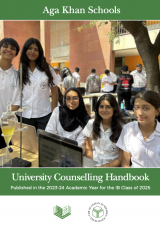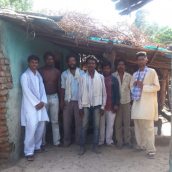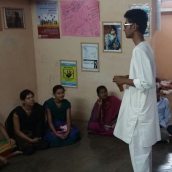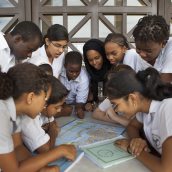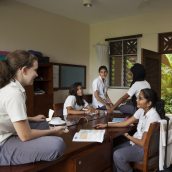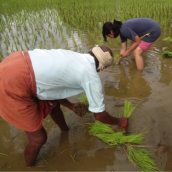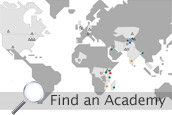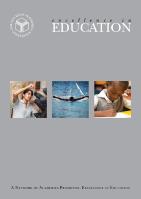How the Aga Khan Academies teach students to value difference
When Rohan Reddy, a senior student at the Aga Khan Academy (AKA) Hyderabad, went to rural India to teach English to other young people, as well as to conduct surveys on child labour and challenges facing local schools, he showed up in a cotton kurta, a traditional Indian shirt he had bought for the occasion in hopes of blending in with locals.
Rohan (far right) with villagers“The irony was that, when we went there, no one was wearing kurtas,” recalled Rohan with a smile on his face. He had expected villagers in Hardha, Madhya Pradesh, where he interned at a non-profit last summer, to be conservative, both in their dress and mindset. But they wore T-shirts and jeans, just as he did at home in Hyderabad.“Do you really wear kurtas in Hyderabad?” locals asked. Over the course of the 25-day internship, Rohan bonded with villagers over food – “They wouldn’t stop serving us,” he said fondly – and through conversations about how Hardha’s lifestyle and culture compared to that of Hyderabad.
Every evening, Rohan spent two hours having conversations and running role plays in English with local youth who wanted to improve their language skills. They were more modern, more interested in education and driven to improve their lives than Rohan had expected. He had assumed they would stop studying after the final year of high school, if they got that far, but many had university degrees in commerce and computer science.
“The stereotypes in my head were shattered,” explained Rohan, who plans to study business at university and was surprised by how much he had in common with Hardha’s youth. “It wasn’t a one-way exchange. It was two ways.”
Rohan teaching EnglishRohan was unaccustomed to the water shortages, limited electricity, poor roads and run-down schools he saw in rural Madhya Pradesh. These factors made it difficult for the villagers to improve their lives. Born and brought up in Hyderabad, one of India’s largest cities, Rohan left with a greater appreciation for the development challenges rural India faces.
The value of pluralism
Internships like the one Rohan participated in are integral to the Academies’ goal of nurturing pluralistic and compassionate leaders, the importance of which was underlined by His Highness the Aga Khan’s lecture at Harvard University in November 2015.
“A pluralist, cosmopolitan society is a society which not only accepts difference, but actively seeks to understand it and to learn from it,” he said. “In this perspective, diversity is not a burden to be endured, but an opportunity to be welcomed.”
“Perhaps it is a natural condition of an insecure human race to see security in a sense of superiority,” His Highness continued. “But in a world where cultures increasingly interpenetrate one another, a more confident and a more generous outlook is needed.”
The pluralistic curriculum
Even though students at the Academies don’t take an exam on pluralism, it is one of the most important elements of the curriculum because of the role that working collaboratively across different communities can play in tackling global problems.
In music and art classes, students are exposed to artistic traditions from all over the world, as well as ones that blend elements from different cultures. They draw inspiration from these to produce their own artistic work. On World Peace Day, they examine how different cultures view peace. In history, students learn about how people from around the world have cooperated in the past, as well as how intolerance has led to discrimination and violence.
Such lessons put contemporary globalisation into perspective and help students see that pluralism is not something new. In one lesson, students learn about a silk robe that was made in Iran out of Chinese silk using an Italian design in the 13th century CE.
A diverse student body helps students learn to collaborate with others who are different.“The robe is a way to help students understand that collaboration across cultures isn’t just something that’s happened in the modern age with the Internet,” explained Alexandra Holland, Curriculum Development Manager at the Aga Khan Academies.
Just as important are the lessons that history provides about the negative and violent consequences of intolerance. The Academy in Mombasa recently redesigned its modern history course to teach students about the negative effect of the absence of pluralism during the Rwandan genocide and the conflict in Kosovo. In Hyderabad, students learn about the actions of the civil rights movements in the US and South Africa as they fought to build more equal societies.
Collaborating across boundaries
But pluralism is deeper than an appreciation of diverse cultures. “It’s not enough for a student to passively understand another culture. It’s about how a student uses that knowledge to work collaboratively and effectively with someone who is different from them,” explained Alexandra. “We focus on putting a lot of collaborative work into the curriculum and having students reflect on how they collaborate with others, what the challenges are and how they can overcome them.”
Teaching students to collaborate starts in the classroom, where students become aware of the positive and negative consequences of social differences. As part of the Aga Khan Academies’ leadership curriculum, grade nine students discuss how gender stereotypes shape their perceptions and behaviour. They examine the ways in which the media portrays men and women, as well as the positive and negative consequences for society.
Similarly, in grade seven, students explore social and economic factors that shape their own lives. In one lesson, students start by standing in a line. They are then asked to take a step forward in response to questions related to privileges they might have – things like whether they’ve travelled abroad, own a pricey electronic device or get a public holiday for a major religious celebration in their community. At the same time, students take a step back in response to questions that highlight a disadvantage – things like whether they have a disability, come from a rural area or don’t have parents who have gone to university.
Students from diverse backgrounds learn to live together in the residences.“This helps them understand they’re not on a level playing field,” said Zohra Lakhani, Student Leadership Programme Manager at the Academies. “It doesn’t always make them feel good to see that, but it’s a reality. These activities help them see the challenges we face in building a truly pluralistic society and the value of pluralism.”
Immersing students in diversity
Outside of class, students from different religious, economic and ethnic backgrounds share meals, play sports, go on trips and attend school events together. In the dormitories, students have to live alongside and learn from their diverse peers. In internships, senior students work with businesses and non-profits that introduce them to people with a range of experiences from different strata of society.
“There is only so far you can go with this through curriculum content. You can’t create the skills and the dispositions students need simply by talking to them about pluralism,” said Alexandra.
Sometimes students gain a new perspective by leaving home. Raj Birgi, a Mombasa student, learned how the private sector in Kenya could ease ethnic divisions in his country after spending time at the Global Centre for Pluralism in Ottawa. In other cases, students work with people at home whom they know little about, such as James Ngumbao, who worked with students on the verge of dropping out of school because of the cost of school fees, as part of the Aga Khan Foundation’s SUCSEED project.
“They understand the challenges that youth in poverty face and learn to help address them without being judgemental,” explained Zohra.
Students also learn not to underestimate the contributions of those with less opportunity than themselves. In Kenya, Natasha Treunen and Barbara Nasila, who were interning with Educating Girls in Science, an AKA outreach project that encourages girls from underprivileged government schools to pursue careers in science, were inspired by a group of girls who started a laundry detergent business. The girls had realised that the detergent sold in the market was expensive and incompatible with the water in their neighbourhood, so they came up with their own formula, stored it in recyclable bottles and sold it to their community at a cheaper rate.
Alisha working in the paddy fields with local farmersSometimes students also communicate across socio-economic boundaries with people who do not speak the same language. When Alisha Ladiwala, a Hyderabad student, interned at a non-profit in rural Kerala, she couldn’t communicate with many villagers because they only spoke Malayalam, the local language. During her internship, Alisha picked up some Malayalam and used facial expressions, gestures and photographs to converse with locals.In this way, she learned that they had limited access to education and were discriminated against because they came from a low caste. She saw them live with bare necessities and waste little – a value she has incorporated into her own life back in Hyderabad.
Her internship has also inspired Alisha to become a social worker. “Donations to support the poor are not enough. You have to take initiative yourself,” she explained. “Through social work, I’ll try to understand their experiences and work with the poor to improve their lives.”
By creating opportunities for students like Alisha to think critically about their world view and to learn about pluralism, the Academies not only aim to influence their attitudes and outlooks, but also how they interact with others and choose to contribute to their society.
By Alia Dharssi
Newsletter readers please click here to return to the newsletter (browser version)
publications
